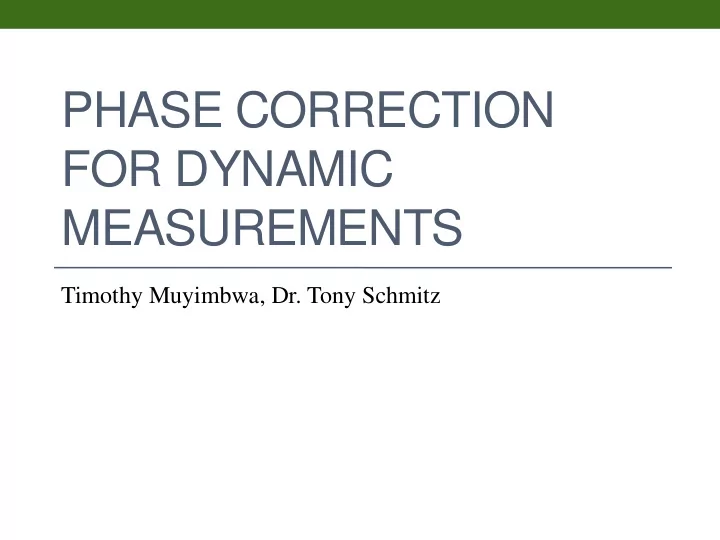

PHASE CORRECTION FOR DYNAMIC MEASUREMENTS Timothy Muyimbwa, Dr. Tony Schmitz
Background • Monitoring vibrations is an important aspect of industrial processes, such as machining operations, in the aerospace, automotive, and medical fields • Measurements allow for early detection of developing problems • Loose connections, resonance, repeating input forces • Transducers measure displacements, changes in velocity, or acceleration • Calibrated statically but applied for dynamic measurements
Problem • The vibrations from a resonating surface, such as the plate, may be measured with a sensor whose amplifying electronics could introduce a time delay between the incident motion and sensor signal • Results in an inaccurate frequency response function for the dynamic measurement
Purpose • characterize the frequency dependency of the phase shift associated with microelectromechanical (MEMS) accelerometers applied to vibration monitoring.
Methodology • Used a piezoelectric accelerometer for reference measurements • Industry leading vibration measurement transducer • Sensors mounted onto modal shaker to provide sinusoidal displacement • The phase lag can be evaluated by determining the phase shift between two sinusoidal signals.
Initial Results Normalized output at 100Hz • Third order Butterworth filter used to smooth output signals • Phase lag ( ∅ ) at a frequency ( ω ) was evaluated using the equation 𝑦 ∙ 𝑧 ∆∅ ( 𝜕 ) = cos −1 𝑦 | 𝑧 | - where x and y denote the two sinusoidal signals
Results 20 0 0 100 200 300 400 500 600 700 800 900 1000 1100 -20 -40 Phase Lag (deg.) -60 -80 -100 -120 -140 -160 -180 -200 Frequency (Hz) • Results were consistent with the expected outcome of higher phase lag at higher vibration frequencies. • Use of analog filters causes the phase lag to increase in a non-linear fashion with larger phase shifts • linearly increasing trend observed from a sensor without an analog filter. • Coinciding curves were averaged to produce a representative curve for each group
Phase Correction • Phase correction requires minimizing the phase shift between the MEMS and PCB accelerometer outputs. • Fitting a trend line to the curve of phase lag allows for a representation of the expected phase trend. o the phase lag was corrected by subtracting the products of the fit equation from the values of phase lag measured at each frequency. slope - Linear Corrected Phase Lag ∅ ( 𝜕 ) 𝑑𝑑𝑑 = ∅ ( 𝜕 ) 𝑛𝑛𝑛𝑛 − ∆ 𝜄 ∗ 𝜕 - Non-Linear Corrected Phase Lag ∅ ( 𝜕 ) 𝑑𝑑𝑑 = ∅ ( 𝜕 ) 𝑛𝑛𝑛𝑛 − ( 𝐷𝐷 ∗ 𝜕 2 + 𝐷 2 ∗ 𝜕 + 𝐷𝐷 )
Curve Fitting 0 0 100 200 300 400 500 600 700 800 900 1000 1100 -5 Fit through Origin Phase Lag Phase Lag (deg.) -10 -15 -20 -25 Frequency (Hz) • Due to the fact that there is no phase lag at zero frequency, a linear regression fit through the origin was evaluated for the linear, non-filtered curve. (shown above) • Non-linear curves (for the analog filtered MEMS accelerometers) used a polynomial fit.
Corrected Phase 20 Triple Axis (X,Y) Phase Error Triple Axis (Z) Phase Error 15 ADXL001 Phase Err. ADXL203 Phase Err.(X) 10 ADXL203 Phase Err.(Y) Phase(deg.) 5 0 0 100 200 300 400 500 600 700 800 900 1000 1100 -5 -10 -15 -20 Frequency (Hz) • Subtracting the fit equation products from the measured produces the above curves representative of corrected phase for the indicated sensor axes. • The noise in the above chart is due to resonance in the mountings of the accelerometers
Conclusion • Correction of the phase lag enables dynamic measurements from the MEMS sensor with increased accuracy. • This method is also adaptable to other transducers and may allow low cost MEMS sensors to be more widely implemented in precision applications.
Recommend
More recommend